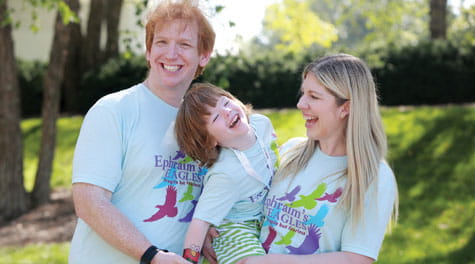Solving the Most Complex Puzzles
When families with rare genetic disorders have nowhere else to turn, Cincinnati Children’s is there
There’s no hiding from Ephraim when he enters a room. Everyone gets a hug. His bright blue eyes shine under his mop of brown hair—he knows no strangers, only friends he hasn’t met yet.
“He’s pure joy,” says Mackenzie, Ephraim’s mom, with a gentle southern lilt. “To see him like this is a miracle.”
Born with three rare genetic disorders, Ephraim faces a host of medical challenges, including problems with eating food by mouth, his kidneys, high blood pressure and more.
“There is no manual on how to care for him,” Mackenzie says, then pauses. “His specialists in Tennessee told us that he was likely the only person in the world with this particular set of disorders.”
Because his conditions are so rare and complex, his doctors struggled with how to manage his care. Ephraim’s health kept declining. Eventually, one specialist advised Mackenzie and her husband, David, to take him home and make him as comfortable as possible.
That wasn't acceptable. They turned to the Division of Nephrology and Hypertension at Cincinnati Children’s. Ranked No. 2 in the nation by U.S. News & World Report, our nephrologists and specialists care for children with the most complex conditions.
Seeing the Whole Picture
Stuart Goldstein, MD, likes puzzles. Which is good, because as the founder and director of our Center for Acute Care Nephrology (CACN), his job involves solving some of the most difficult health problems that come through our doors.
“As the main filters of a person’s blood supply, kidneys are intimately connected with all the organ systems throughout the body,” says Dr. Goldstein. “Treatments for something seemingly unrelated, like medications for epilepsy, can end up hurting the kidneys.”
Because loss of kidney function can have so many causes, Dr. Goldstein and his team work closely with divisions and departments throughout the medical center. That comprehensive, team medicine approach is why the CACN is an internationally recognized resource.
Putting the Pieces Together
Mackenzie and David transferred Ephraim’s care to Dr. Goldstein and began traveling to Cincinnati Children’s. During one of these visits, Ephraim lost consciousness and dropped to the floor, unresponsive.
“We’d been dealing with these episodes for some time, and no one had been able to tell us why they happened,” Mackenzie recalls. “But Dr. Goldstein was determined to figure it out. We explained that when Ephraim was on a certain medication, this didn’t happen. But, because the medicine caused kidney problems, he’d been taken off it.”
This kind of puzzle was why Dr. Goldstein became a nephrologist. He wanted to admit Ephraim for a week-long stay with the complex care team, so they could carefully monitor his condition and methodically adjust his treatments to improve his quality of life.
What transpired during that week can only be described as miraculous. By trying new treatments, eliminating or adjusting others, Ephraim began to thrive. Within 10 days, he was released from the hospital, and with no unconscious episodes in nearly a week.
“I wanted all of his providers working together and speaking daily about his progress,” Dr. Goldstein says. “Because this was the first time that all Ephraim’s care was under one roof, I hoped we could affect major, positive changes in his life.”
Two months later, Ephraim celebrated his fifth birthday—it was the first time he could eat his birthday cake. Mackenzie smiles at the memory. “It was the first birthday where I didn’t worry and wonder whether it would be the last party I’d get to plan for him. That is a gift for which I can never adequately express my gratitude.”
Collaboration Transforms the Future
Dr. Goldstein gives all credit for Ephraim’s incredible journey to the culture of collaboration that’s inherent throughout Cincinnati Children’s.
“It was all of Ephraim’s specialists working together that enabled that transformative change in him,” he says. “Our program here is virtually one-of-a-kind. The cooperative nature—in both research and clinical care—is far above anywhere else.”
Dr. Goldstein enters the exam room for a follow-up visit with Ephraim. Before he has a chance to greet Mackenzie, Ephraim runs to him, arms wide. Laughing, Dr. Goldstein scoops him up and returns the exuberant embrace.
“I love you,” Ephraim says to Dr. Goldstein. “Thank you for making me better so I can eat my cake!”
To learn more and support our work within the Division of Nephrology and Hypertension, please contact Lauren Bosse at lauren.bosse@cchmc.org or 513-803-0639.






